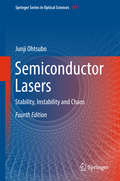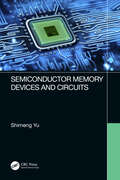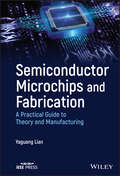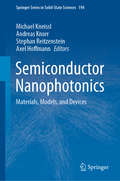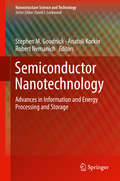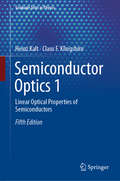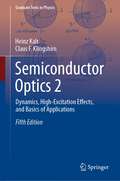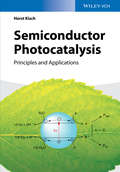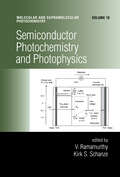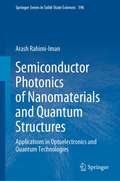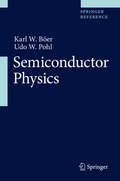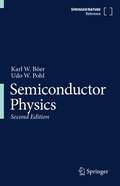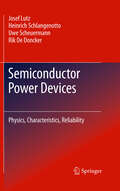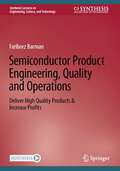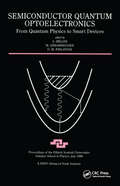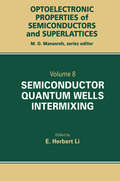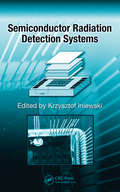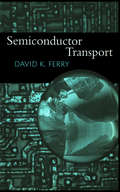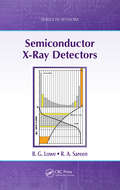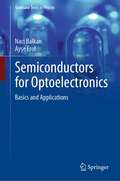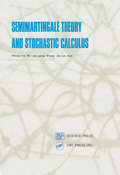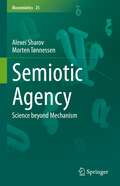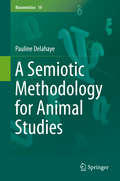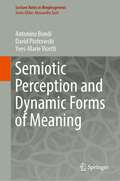- Table View
- List View
Semiconductor Lasers
by Junji OhtsuboThis third edition of "Semiconductor Lasers, Stability, Instability and Chaos" was significantly extended. In the previous edition, the dynamics and characteristics of chaos in semiconductor lasers after the introduction of the fundamental theory of laser chaos and chaotic dynamics induced by self-optical feedback and optical injection was discussed. Semiconductor lasers with new device structures, such as vertical-cavity surface-emitting lasers and broad-area semiconductor lasers, are interesting devices from the viewpoint of chaotic dynamics since they essentially involve chaotic dynamics even in their free-running oscillations. These topics are also treated with respect to the new developments in the current edition. Also the control of such instabilities and chaos control are critical issues for applications. Another interesting and important issue of semiconductor laser chaos in this third edition is chaos synchronization between two lasers and the application to optical secure communication. One of the new topics in this edition is fast physical number generation using chaotic semiconductor lasers for secure communication and development of chaos chips and their application. As other new important topics, the recent advance of new semiconductor laser structures is presented, such as quantum-dot semiconductor lasers, quantum-cascade semiconductor lasers, vertical-cavity surface-emitting lasers and physical random number generation with application to quantum key distribution. Stabilities, instabilities, and control of quantum-dot semiconductor lasers and quantum-cascade lasers are important topics in this field.
Semiconductor Memory Devices and Circuits
by Shimeng YuThis book covers semiconductor memory technologies from device bit-cell structures to memory array design with an emphasis on recent industry scaling trends and cutting-edge technologies. The first part of the book discusses the mainstream semiconductor memory technologies. The second part of the book discusses the emerging memory candidates that may have the potential to change the memory hierarchy, and surveys new applications of memory technologies for machine/deep learning applications. This book is intended for graduate students in electrical and computer engineering programs and researchers or industry professionals in semiconductors and microelectronics. Explains the design of basic memory bit-cells including 6-transistor SRAM, 1-transistor-1-capacitor DRAM, and floating gate/charge trap FLASH transistor Examines the design of the peripheral circuits including the sense amplifier and array-level organization for the memory array Examines industry trends of memory technologies such as FinFET based SRAM, High-Bandwidth-Memory (HBM), 3D NAND Flash, and 3D X-point array Discusses the prospects and challenges of emerging memory technologies such as PCM, RRAM, STT-MRAM/SOT-MRAM and FeRAM/FeFET Explores the new applications such as in-memory computing for AI hardware acceleration.
Semiconductor Microchips and Fabrication: A Practical Guide to Theory and Manufacturing
by Yaguang LianSemiconductor Microchips and Fabrication Advanced and highly illustrated guide to semiconductor manufacturing from an experienced industry insider Semiconductor Microchips and Fabrication is a practical yet advanced book on the theory, design, and manufacturing of semiconductor microchips that describes the process using the principles of physics and chemistry, fills in the knowledge gaps for professionals and students who need to know how manufacturing equipment works, and provides valuable suggestions and solutions to many problems that students or engineers often encounter in semiconductor processing, including useful experiment results to help in process work. The explanation of the semiconductor manufacturing process, and the equipment needed, is carried out based on the machines that are used in clean rooms over the world so readers understand how they can use the equipment to achieve their design and manufacturing ambitions. Combining theory with practice, all descriptions are carried out around the actual equipment and processes by way of a highly visual text, with illustrations including equipment pictures, manufacturing process schematics, and structures of semiconductor microchips. Sample topics covered in Semiconductor Microchips and Fabrication include: An introduction to basic concepts, such as impedance mismatch from plasma machines and theories, such as energy bands and Clausius-Clapeyron equation Basic knowledge used in semiconductor devices and manufacturing machines, including DC and AC circuits, electric fields, magnetic fields, resonant cavity, and the components used in the devices and machines Transistor and integrated circuits, including bipolar transistors, junction field effect transistors, and metal-semiconductor field effect transistors The main processes used in the manufacturing of microchips, including lithography, metallization, reactive-ion etching (RIE), plasma-enhanced chemical vapor deposition (PECVD), thermal oxidation and implantation, and more The skills in the design and problem solving of processes, such as how to design a dry etching recipe, and how to solve the micro-grass problems in Bosch process Through Semiconductor Microchips and Fabrication, readers can obtain the fundamental knowledge and skills of semiconductor manufacturing, which will help them better understand and use semiconductor technology to improve their product quality or project research. Before approaching this text, readers should have basic knowledge of physics, chemistry, and circuitry.
Semiconductor Nanophotonics: Materials, Models, and Devices (Springer Series in Solid-State Sciences #194)
by Andreas Knorr Michael Kneissl Axel Hoffmann Stephan ReitzensteinThis book provides a comprehensive overview of the state-of-the-art in the development of semiconductor nanostructures and nanophotonic devices. It covers epitaxial growth processes for GaAs- and GaN-based quantum dots and quantum wells, describes the fundamental optical, electronic, and vibronic properties of nanomaterials, and addresses the design and realization of various nanophotonic devices. These include energy-efficient and high-speed vertical cavity surface emitting lasers (VCSELs) and ultra-small metal-cavity nano-lasers for applications in multi-terabus systems; silicon photonic I/O engines based on the hybrid integration of VCSELs for highly efficient chip-to-chip communication; electrically driven quantum key systems based on q-bit and entangled photon emitters and their implementation in real information networks; and AlGaN-based deep UV laser diodes for applications in medical diagnostics, gas sensing, spectroscopy, and 3D printing. The experimental results are accompanied by reviews of theoretical models that describe nanophotonic devices and their base materials. The book details how optical transitions in the active materials, such as semiconductor quantum dots and quantum wells, can be described using a quantum approach to the dynamics of solid-state electrons under quantum confinement and their interaction with phonons, as well as their external pumping by electrical currents. With its broad and detailed scope, this book is indeed a cutting-edge resource for researchers, engineers and graduate-level students in the area of semiconductor materials, optoelectronic devices and photonic systems.
Semiconductor Nanotechnology: Advances in Information and Energy Processing and Storage (Nanostructure Science and Technology)
by Stephen M. Goodnick Anatoli Korkin Robert NemanichThis book presents research dedicated to solving scientific and technological problems in many areas of electronics, photonics and renewable energy. Energy and information are interconnected and are essential elements for the development of human society. Transmission, processing and storage of information requires energy consumption, while the efficient use and access to new energy sources requires new information (ideas and expertise) and the design of novel systems such as photovoltaic devices, fuel cells and batteries. Semiconductor physics creates the knowledge base for the development of information (computers, cell phones, etc.) and energy (photovoltaic) technologies. The exchange of ideas and expertise between these two technologies is critical and expands beyond semiconductors. Continued progress in information and renewable energy technologies requires miniaturization of devices and reduction of costs, energy and material consumption. The latest generation of electronic devices is now approaching nanometer scale dimensions, new materials are being introduced into electronics manufacturing at an unprecedented rate, and alternative technologies to mainstream CMOS are evolving. Nanotechnology is widely accepted as a source of potential solutions in securing future progress for information and energy technologies.Semiconductor Nanotechnology features chapters that cover the following areas: atomic scale materials design, bio- and molecular electronics, high frequency electronics, fabrication of nanodevices, magnetic materials and spintronics, materials and processes for integrated and subwave optoelectronics, nanoCMOS, new materials for FETs and other devices, nanoelectronics system architecture, nano optics and lasers, non-silicon materials and devices, chemical and biosensors, quantum effects in devices, nano science and technology applications in the development of novel solar energy devices, and fuel cells and batteries.
Semiconductor Optics 1: Linear Optical Properties of Semiconductors (Graduate Texts in Physics)
by Heinz Kalt Claus F. KlingshirnThis revised and updated edition of the well-received book by C. Klingshirn provides an introduction to and an overview of all aspects of semiconductor optics, from IR to visible and UV. It has been split into two volumes and rearranged to offer a clearer structure of the course content. Inserts on important experimental techniques as well as sections on topical research have been added to support research-oriented teaching and learning. Volume 1 provides an introduction to the linear optical properties of semiconductors. The mathematical treatment has been kept as elementary as possible to allow an intuitive approach to the understanding of results of semiconductor spectroscopy. Building on the phenomenological model of the Lorentz oscillator, the book describes the interaction of light with fundamental optical excitations in semiconductors (phonons, free carriers, excitons). It also offers a broad review of seminal research results augmented by concise descriptions of the relevant experimental techniques, e.g., Fourier transform IR spectroscopy, ellipsometry, modulation spectroscopy and spatially resolved methods, to name a few. Further, it picks up on hot topics in current research, like quantum structures, mono-layer semiconductors or Perovskites. The experimental aspects of semiconductor optics are complemented by an in-depth discussion of group theory in solid-state optics. Covering subjects ranging from physics to materials science and optoelectronics, this book provides a lively and comprehensive introduction to semiconductor optics. With over 120 problems, more than 480 figures, abstracts to each chapter, as well as boxed inserts and a detailed index, it is intended for use in graduate courses in physics and neighboring sciences like material science and electrical engineering. It is also a valuable reference resource for doctoral and advanced researchers.
Semiconductor Optics 2: Dynamics, High-Excitation Effects, and Basics of Applications (Graduate Texts in Physics)
by Heinz Kalt Claus F. KlingshirnThis book provides an introduction to and an overview of the multifaceted area of dynamics and nonlinearities related to optical excitations in semiconductors. It is a revised and significantly extended edition of the well-established book by C. Klingshirn split into two volumes and restructured to make it more concise. Inserts on important experimental techniques, reference to topical research and novel materials, as well as consideration of photonic applications support research-oriented teaching and learning. This book reviews nonlinear optical properties and many-body phenomena evoked by high densities of quasi-particles in semiconductors. Coherent dynamics and relaxation of optical excitations (carriers, excitons, electron–hole plasmas, etc.) as well as condensation phenomena are elucidated in these materials. A broad overview is provided of seminal research results augmented by detailed descriptions of the relevant experimental techniques, e.g., ultrafastspectroscopy, four-wave mixing, and the Hanbury-Brown and Twiss experiment. Offering a comprehensive introduction to hot topics in current research — polariton condensates, valley coherence, and single photons, to name a few, it also discusses applications of the described physical concepts in topical areas, such as quantum information, photonics, spintronics, and optoelectronics.Covering subjects ranging from physics to materials science and optoelectronics, the book provides a lively and comprehensive introduction to semiconductor optics beyond the linear regime.With many problems, chapter introductions, schematic depictions of physical phenomena, as well as boxed inserts and a detailed index, it is suitable for use in graduate courses in physics and neighboring sciences like material science and optical communication. It is also a valuable reference resource for doctoral and advanced researchers.
Semiconductor Photocatalysis
by Horst KischFocusing on the basic principles of semiconductor photocatalysis, this book also gives a brief introduction to photochemistry, photoelectrochemistry, and homogeneous photocatalysis. In addition, the author - one of the leading authorities in the field - presents important environmental and practical aspects. A valuable, one-stop source for all chemists, material scientists, and physicists working in this area, as well as novice researchers entering (semiconductor) photocatalysis.
Semiconductor Photochemistry And Photophysics/Volume Ten
by V. Ramamurthy Kirk S. SchanzeAnswering the need for information that could revolutionize the development of alternate solar energy sources and the reduction of atmospheric contaminants, Semiconductor Photochemistry and Photophysics reflects renewed interest inspired by the unique properties of nanocrystalline semiconductor particles. It provides a thorough overview and describ
Semiconductor Photonics of Nanomaterials and Quantum Structures: Applications in Optoelectronics and Quantum Technologies (Springer Series in Solid-State Sciences #196)
by Arash Rahimi-ImanThis book introduces the wider field of functional nanomaterials sciences, with a strong emphasis on semiconductor photonics. Whether you are studying photonic quantum devices or just interested in semiconductor nanomaterials and their benefits for optoelectronic applications, this book offers you a pedagogical overview of the relevant subjects along with topical reviews. The book discusses different yet complementary studies in the context of ongoing international research efforts, delivering examples from both fundamental and applied research to a broad readership. In addition, a hand-full of useful optical techniques for the characterization of semiconductor quantum structures and materials are addressed. Moreover, nanostructuring methods for the production of low-dimensional systems, which exhibit advantageous properties predominantly due to quantum effects, are summarized. Science and engineering professionals in the interdisciplinary domains of nanotechnology, photonics, materials sciences, and quantum physics can familiarize themselves with selected highlights with eyes towards photonic applications in the fields of two-dimensional materials research, light–matter interactions, and quantum technologies.
Semiconductor Physics: Introduction To Physical Principles (Graduate Texts in Physics #4)
by Karl W. Böer Udo W. PohlThis handbook gives a complete survey of the important topics and results in semiconductor physics. It addresses every fundamental principle and most research topics and areas of application in the field of semiconductor physics. Comprehensive information is provided on crystalline bulk and low-dimensional as well as amporphous semiconductors, including optical, transport, and dynamic properties.
Semiconductor Physics
by Karl W. Böer Udo W. PohlThis handbook gives a complete and detailed survey of the field of semiconductor physics. It addresses every fundamental principle, the most important research topics and results, as well as conventional and emerging new areas of application. Additionally it provides all essential reference material on crystalline bulk, low-dimensional, and amorphous semiconductors, including valuable data on their optical, transport, and dynamic properties.This updated and extended second edition includes essential coverage of rapidly advancing areas in semiconductor physics, such as topological insulators, quantum optics, magnetic nanostructures and spintronic systems. Richly illustrated and authored by a duo of internationally acclaimed experts in solar energy and semiconductor physics, this handbook delivers in-depth treatment of the field, reflecting a combined experience spanning several decades as both researchers and educators. Offering a unique perspective on many issues, Semiconductor Physics is an invaluable reference for physicists, materials scientists and engineers throughout academia and industry.
Semiconductor Power Devices
by Heinrich Schlangenotto Josef Lutz Rik De Doncker Uwe ScheuermannSemiconductor power devices are the heart of power electronics. They determine the performance of power converters and allow topologies with high efficiency. Semiconductor properties, pn-junctions and the physical phenomena for understanding power devices are discussed in depth. Working principles of state-of-the-art power diodes, thyristors, MOSFETs and IGBTs are explained in detail, as well as key aspects of semiconductor device production technology. In practice, not only the semiconductor, but also the thermal and mechanical properties of packaging and interconnection technologies are essential to predict device behavior in circuits. Wear and aging mechanisms are identified and reliability analyses principles are developed. Unique information on destructive mechanisms, including typical failure pictures, allows assessment of the ruggedness of power devices. Also parasitic effects, such as device induced electromagnetic interference problems, are addressed. The book concludes with modern power electronic system integration techniques and trends.
Semiconductor Product Engineering, Quality and Operations: Deliver High Quality Products & Increase Profits (Synthesis Lectures on Engineering, Science, and Technology)
by Fariborz BarmanThis book captures the author’s 35+ years of learning & experience in the semiconductor chip industry to provide a proven roadmap for successful, new product introduction process, tailored specifically to the semiconductor industry. The content includes a simplified process flow, success metrics, execution guidelines, checklists & calculators. The presentation is based on a product engineering centric “NPI hub” and the author guides readers through the complete process of semiconductor new product introduction, ensuring a successful plan execution.
Semiconductor Quantum Optics
by Mackillo Kira Stephan W. KochThe emerging field of semiconductor quantum optics combines semiconductor physics and quantum optics, with the aim of developing quantum devices with unprecedented performance. In this book researchers and graduate students alike will reach a new level of understanding to begin conducting state-of-the-art investigations. The book combines theoretical methods from quantum optics and solid-state physics to give a consistent microscopic description of light-matter- and many-body-interaction effects in low-dimensional semiconductor nanostructures. It develops the systematic theory needed to treat semiconductor quantum-optical effects, such as strong light-matter coupling, light-matter entanglement, squeezing, as well as quantum-optical semiconductor spectroscopy. Detailed derivations of key equations help readers learn the techniques and nearly 300 exercises help test their understanding of the materials covered. The book is accompanied by a website hosted by the authors, containing further discussions on topical issues, latest trends and publications on the field. The link can be found at www. cambridge. org/9780521875097.
Semiconductor Quantum Optoelectronics: From Quantum Physics to Smart Devices (Scottish Graduate Ser. #50)
by A Miller; M Ebrahimzadeh; D M FinlaysonThe development and application of low-dimensional semiconductors have been rapid and spectacular during the past decade. Ever improving epitaxial growth and device fabrication techniques have allowed access to some remarkable new physics in quantum confined structures while a plethora of new devices has emerged. The field of optoelectronics in particular has benefited from these advances both in terms of improved performance and the invention of fundamentally new types of device, at a time when the use of optics and lasers in telecommunications, broadcasting, the Internet, signal processing, and computing has been rapidly expanding. An appreciation of the physics of quantum and dynamic electronic processes in confined structures is key to the understanding of many of the latest devices and their continued development.Semiconductor Quantum Optoelectronics covers new physics and the latest device developments in low-dimensional semiconductors. It allows those who already have some familiarity with semiconductor physics and devices to broaden and expand their knowledge into new and expanding topics in low-dimensional semiconductors. The book provides pedagogical coverage of selected areas of new and pertinent physics of low-dimensional structures and presents some optoelectronic devices presently under development. Coverage includes material and band structure issues and the physics of ultrafast, nonlinear, coherent, intersubband, and intracavity phenomena. The book emphasizes various devices, including quantum wells, visible, quantum cascade, and mode-locked lasers; microcavity LEDs and VCSELs; and detectors and logic elements. An underlying theme is high-speed phenomena and devices for increased system bandwidths.
Semiconductor Quantum Well Intermixing: Material Properties and Optoelectronic Applications
by E. Herbert LiSemiconductor Quantum Well Intermixing is an international collection of research results dealing with several aspects of the diffused quantum well (DFQW), ranging from Physics to materials and device applications. The material covered is the basic interdiffusion mechanisms of both cation and anion groups as well as the properties of band structure
Semiconductor Radiation Detection Systems (Devices, Circuits, and Systems)
by Krzysztof IniewskiSemiconductor Radiation Detection Systems addresses the state-of-the-art in the design of semiconductor detectors and integrated circuit design, in the context of medical imaging using ionizing radiation. It addresses exciting new opportunities in X-ray detection, Computer Tomography (CT), bone dosimetry, and nuclear medicine (PET, SPECT). In addition to medical imaging, the book explores other applications of semiconductor radiation detection systems in security applications such as luggage scanning, dirty bomb detection, and border control. Features a chapter written by well-known Gamma-Ray Imaging authority Tadayuki Takahashi Assembled by a combination of top industrial experts and academic professors, this book is more than just a product manual. It is practical enough to provide a solid explanation of presented technologies, incorporating material that offers an optimal balance of scientific and academic theory. With less of a focus on math and physical details, the author concentrates more on exploring exactly how technologies are being used. With its combined coverage of new materials and innovative new system approaches, as well as a succinct overview of recent developments, this book is an invaluable tool for any engineer, professional, or student working in electronics or an associated field.
Semiconductor Transport (Physics Of Solids And Liquids Ser. #52)
by David FerryThe information revolution would have been radically different, or impossible, without the use of the materials known generically as semiconductors. The properties of these materials, particularly the potential for doping with impurities to create transistors and diodes and controlling the local potential by gates, are essential for microelectronics.Semiconductor Transport is an introductory text on electron transport in semiconductor materials and is written for advanced undergraduates and graduate students. The book provides a thorough treatment of modern approaches to the transport properties of semiconductors and their calculation. It also introduces those aspects of solid state physics, which are vitally important for understanding transport in them.
Semiconductor X-Ray Detectors (ISSN #12)
by B. G. Lowe R. A. SareenIdentifying and measuring the elemental x-rays released when materials are examined with particles (electrons, protons, alpha particles, etc.) or photons (x-rays and gamma rays) is still considered to be the primary analytical technique for routine and non-destructive materials analysis. The Lithium Drifted Silicon (Si(Li)) X-Ray Detector, with its
Semiconductors for Optoelectronics: Basics and Applications (Graduate Texts in Physics)
by Naci Balkan Ayşe ErolThis book provides in-depth knowledge about the fundamental physical properties of bulk and low dimensional semiconductors (LDS). It also explains their applications to optoelectronic devices. The book incorporates two major themes. The first theme, starts from the fundamental principles governing the classification of solids according to their electronic properties and leads to a detailed analysis of electronic band structure and electronic transport in solids. It then focuses on the electronic transport and optical properties of semiconductor compounds, size quantization and the analysis of abrupt p-n junctions where a full analysis of the fundamental properties of intrinsic and doped semiconductors is given. The second theme is device-oriented. It aims to provide the reader with understanding of the design, fabrication and operation of optoelectronic devices based on novel semiconductor materials, such as high-speed photo detectors, light emitting diodes, multi-mode and single-mode lasers and high efficiency solar cells. The book appeals to researchers and high-level undergraduate students.
Semimartingale Theory and Stochastic Calculus
by Sheng-Wu He Jia-Gang Wang Jia-an YanSemimartingale Theory and Stochastic Calculus presents a systematic and detailed account of the general theory of stochastic processes, the semimartingale theory, and related stochastic calculus. The book emphasizes stochastic integration for semimartingales, characteristics of semimartingales, predictable representation properties and weak convergence of semimartingales. It also includes a concise treatment of absolute continuity and singularity, contiguity, and entire separation of measures by semimartingale approach. Two basic types of processes frequently encountered in applied probability and statistics are highlighted: processes with independent increments and marked point processes encountered frequently in applied probability and statistics. Semimartingale Theory and Stochastic Calculus is a self-contained and comprehensive book that will be valuable for research mathematicians, statisticians, engineers, and students.
Semiotic Agency: Science beyond Mechanism (Biosemiotics #25)
by Alexei Sharov Morten TønnessenThis book invites readers to embark on a journey into the world of agency encompassing humans, other organisms, cells, intracellular molecular agents, colonies, populations, ecological systems, and artificial autonomous systems. We combine mechanistic and non-mechanistic approaches in the analysis of the function and evolution of organisms, their subagents, and multi-organism systems, and in this way offer a theoretical platform for integrating biosemiotics with both natural science and the humanities/social sciences. Agents are autonomous systems that incorporate knowledge on how to make sense of their environment and use it to achieve their goals. The functions of all agents are supported by mechanisms at the lowest level; however, the explanatory power of mechanistic analysis is not sufficient for complex agents. Non-mechanistic methods rely on the goal-directedness of agents whose dynamics follow self-stabilized dynamic attractors. The properties of attractors depend on stable or slowly changing factors, and such dependencies can be interpreted as sign relations if they are adaptive in nature. Agents can replace or redirect mechanisms on demand in order to preserve their functions; for performing higher-level semiotic functions, mechanisms are thus only means. We assume that mechanism and semiosis are not mutually exclusive, and that simple agents can interpret signs mechanistically. This assumption allows us to extend semiotic analysis to all agents, including ribosomes in cells, computers, and robots. This book challenges established traditions in natural science and the humanities/social sciences: semiotics no longer appears as restricted to humans and rational thinking, and biology is no longer limited to rely exclusively on mechanistic reasoning.
A Semiotic Methodology for Animal Studies (Biosemiotics #19)
by Pauline DelahayeThis monograph is about new perspective in animal studies methodology, by using concepts and tools from the field of semiotics. It proposes a reflexion on current challenges and issues in the ethology field, and introduces different semiotics – biosemiotics, zoosemiotics – as potential methodological solutions. The chapters cover many aspects of ethology where semiotics can be a helpful hand: studies of language, culture, cognition or emotions, issues about complex, endangered or variable species. It explains why these points are difficult to study for actual ethology, why they still matter for researchers, biodiversity actors or wildlife programs, and how an interdisciplinary study with a semiotic point of view can help understand them. This book will appeal to a wide readership, from researchers and academics in living sciences as well as in linguistics fields, to other professionals – veterinarian, wildlife managers, zookeepers, and many others – who feel the need to better understand some aspects of animals they are working with. Students with animal focus should read this book as an introduction to interdisciplinary methodology, and a proposition to work differently with animals.
Semiotic Perception and Dynamic Forms of Meaning (Lecture Notes in Morphogenesis)
by Antonino Bondi David Piotrowski Yves-Marie VisettiWhat do we mean by semiotic perception? Why should the concepts of perception and expressivity be reinterpreted within the encompassing framework of a dynamic theory of semiotic fields and forms? Can we redeploy the concept of form in such a way as to make explicit such a native solidarity (‘chiasmatic’ would have said Merleau-Ponty) between perception, praxis and expression -- and first and foremost in the activity of language, right to the heart of the life of the social and speaking animal that we are? What then would be the epistemological and ontological consequences, and how might this affect the way we describe semiolinguistic forms? This book aims to provide answers to these questions by opening up avenues of research on how to understand the linguistic and semiotic dimensions at work in the constitution of experience, both individual and collective.
